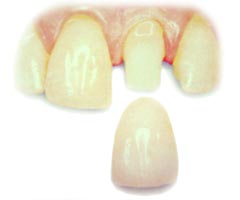http://our-medical-center.blogspot.com/2008/01/porcelain-crowns.html
| With old technology, dental crowns always needed to be made with a metal foundation. Today, we can make them out of pure porcelain, ceramic or aesthetic reinforced resins. There are still occasions on the back teeth when the durability of a metal crown makes it the restoration of choice. But for crowns that show, wouldn't you rather have one that looks as natural as possible? See photos at the bottom of the page that show the beauty of pure porcelain. |  |
It is needed when a tooth is badly broken down - there are existing large fillings or a large area of tooth decay, because a filling isn't strong enough. And in the front of the mouth, you will want a porcelain crown that looks exactly like a tooth. If done by an expert cosmetic dentist, it will be very difficult for people to tell that it isn't real. For information on locating an expert cosmetic dentist in your area, please see our cosmetic dentist referral page.
 | Years ago, it had to be fused to a metal framework in order to create a crown strong enough to resist breaking in use. But bonding technology developed since the 1980s has allowed dentists to bond these ceramic crowns directly to the teeth. With this strong bond, it becomes strong enough to function under even heavy chewing pressures. The photo to the left shows one that is functioning even under the heavy stresses of a molar tooth. |
A beautiful porcelain crown may have a cost that exceed your dental insurance plan allotment. If your interests are purely functional - you don't care how it looks - then you may not want to spend the extra money.
On back teeth, many cosmetic dentists do what are called porcelain onlays. These are very similar to all crowns, and sometimes the terms are used interchangeably. Using the term onlay, however, means that we are grinding away less of the tooth - we leave the healthy tooth structure alone as much as possible. With an onlay, since we can keep the margins away from the gum, we greatly reduce the tendency to gum inflammation that can occur with dental crowns. It also is metal-free. However, under very heavy biting pressures, there is a cracking risk with a porcelain onlay.
Dentists need special training in cosmetic dentistry in order to place these restorations. If you would like referral to a competent cosmetic dentist who is trained to do this type of work, feel free to e-mail Dr. Hall with your request.
The Cerec crown is merely a variation of all-porcelain. It is made out of all ceramic, but rather than being made by a laboratory technician, it is milled by a computer in the dentist's office.
The Empress crown is also a variation of all-porcelain which uses the Empress pressed ceramic material. Other ceramic materials are Procera, In-Ceram, and feldspathic porcelain. A cosmetic dentist will be familiar with all of these materials and will use the best crown for each clinical situation. They all have their advantages and disadvantages.
Porcelain fused to metal crowns have a nearly natural appearance, subject to two limitations: Because they have a metal framework underneath, they require the use of an opaquer to cover the metal, which makes it impossible to re-create the translucency of natural teeth. They also eventually will show a dark line at the edge, next to the gum. Dentists try to hide this line under the gum, but sometimes they are unable to do this; and sometimes the line doesn't show when the crown is first placed but shows later, as the gum recedes. But they are stronger than all porcelain.
Below is a comparison of the appearance of porcelain fused to metal with bonded all-ceramic. Notice the picture on the left: Jo has several crowns across the front. Even though I have never met this patient and know nothing more than these pictures, I can pick out immediately the teeth that have crowns on them. How? Because they are opaque and have a dark line near the gumline. Contrast this with the after picture of Jo's teeth on the right, which shows beautiful bonded all-ceramic work. This work was done by Dr. Craig Carlson, a www.mynewsmile.com cosmetic dentist from San Antonio, Texas. See how natural they look. For contact information for Dr. Carlson, please see our Texas cosmetic dentists page.
Here is another example on a patient of mynewsmile.com network dentist Dr. Duane Delaune of Metairie, Louisiana. (See our Louisiana cosmetic dentists page. This patient had a mal-formed lateral incisor that made her self-conscious. Notice the beauty of the crown in the after picture that blends so perfectly with her natural teeth. You have to view the larger version of this case to fully appreciate it:
![]()
Read about dental bridges, and about the ovate pontic technique for creating the illusion that the false tooth is growing out of the gum.
You may also want to read Dr. Hall's blog posts about porcelain crowns, where he answers questions from visitors.
from mynewsmile.com
http://our-medical-center.blogspot.com/2008/01/porcelain-crowns.html





0 comments:
Post a Comment